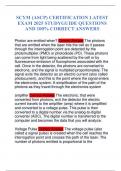Exam (elaborations)
SCYM (ASCP) CERTIFICATION LATEST EXAM 2025 STUDYGUIDE QUESTIONS AND 100% CORRECT ANSWERS
- Course
- SCYM
- Institution
- Johns Hopkins University
SCYM (ASCP) CERTIFICATION LATEST EXAM 2025 STUDYGUIDE QUESTIONS AND 100% CORRECT ANSWERS
[Show more]



